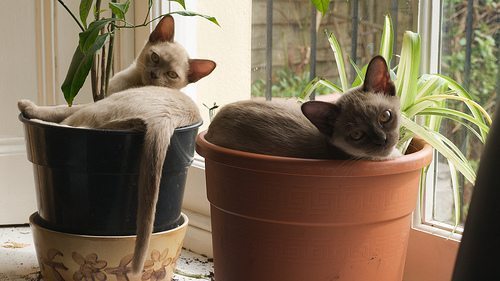Cats are naturally curious creatures, hence that old saying about what curiosity did to the cat. When you adopt a cat, you need to make sure that your home is safe so your cat doesn’t get injured or worse. You also need to do this to protect your belongings. Use these steps to cat proof your home and enjoy your time with your new family member.
Start by thinking like a cat. Get down low and roam your house. What can you get to? What can you pull on or play with? When you get down to your cat’s level and think like a cat, you may notice some things that you otherwise wouldn’t.
Plants
Protect your plants, and protect your cat from potentially poisonous plants. There are many plants that are perfectly safe for humans, but if ingested by a cat they can be fatal. Cats tend to love to chew on any type of plants, even flowers. They don’t know which ones will be poisonous to them, so you need to keep them all out of reach. Hang plants from the ceiling or place them on the mantle. It’s best to just keep all plants where your cat cannot get to them rather than trying to figure out which ones could be poisonous and which ones aren’t.
Valuables
If you have breakable items, they will need to be put somewhere safe. Cats love to jump and explore. They will jump up on mantles, shelves, tables, and countertops. Keep valuables and any breakable items where your cat won’t be able to knock them over.
Cover your cloth furniture with a large blanket or a fitted, custom cover to protect it from getting scratched and chewed. Make sure that whatever you cover your furniture with is thick enough to protect it from cat scratches.
Poisons
Antifreeze is a hazard because it is poisonous, but tastes and smells sweet. Keep this out of reach, along with all of your other cleaning supplies. Cats can sometimes open cabinet doors, so keeping them in a cabinet or closet isn’t quite good enough unless they are up high where your cat couldn’t possibly reach them. You can use baby locks on your cabinet doors to keep your cat from opening them.
Avoid pine-based cleaners, as well as any containing phenol. Both are toxic to cats.
Cords
Tie up blind cords to keep them away from your cat. Those strings are fun for her to play with, but she can end up getting injured or strangled. Cats also like to play with electrical cords, which are also very dangerous for them. There are plastic tube-like covers you can buy for your electrical cords to keep them protected and organized (look in the baby-proofing section of a store like Target or Wal-Mart). This will also keep them safe from your cat.
Choking Hazards
Cats like to bite and chew on things even if it’s not a toy or food. Cat choking hazards include tinsel, wrappers, rubber bands, and basically anything small enough for them to swallow. Keep these things out of reach, and avoid tinsel or anything similar during the holidays. Think about whether or not a cat would like to play with something before you buy it.
Now that you have cat proofed your house you are ready for her to come home! Set up a welcome home room (use the room where her litter box will be located). Bring your cat home in the cat carrier straight to that room and shut the door. Open the door to the carrier and give your new cat some space. She will come out when she is ready. After she comes out and starts exploring, open the door to the room to allow her to explore her new home when she is ready. Your cat will feel more comfortable being eased into her new home this way.
Enjoy your new family member and stay safe!
Photo: Courtesy of shellac via Flickr (CC by 2.0)










